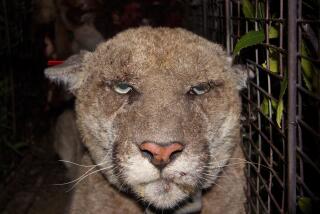Rats and Humans Vie for Room in Riverside
RIVERSIDE — Out here in Riverside County, the Stephen’s kangaroo rat, a country cousin of ground squirrels no bigger than a city mouse, is fighting for survival.
In “Who Framed Roger Rabbit?” cartoon characters live in Toon Town, a place threatened with extinction from developers and freeways. The futuristic blueprint for some shining city on a hill threatens to pave over the imagination, along with open spaces. Miraculously, cartoon characters triumph over city planners, much to the satisfaction of nostalgic moviegoers who drive to theaters on freeways that replaced open spaces.
In Eagle Rock, the founding boulder has recently been threatened by a housing project that would obscure its view. Citizens protested. Their vision of the landmark was preserved. The need for human housing competed with a rock and the rock won.
Most kangaroo rats live happily in the desert or in hilly chaparral, well removed from cities. But the Stephen’s species is different, living off flat grasslands in western portions of the county, where the market for new homes is insatiable and where the middle class of California humans can still afford to live. Unlike a landmark rock, the Stephen’s kangaroo rat is soon to be officially protected by the Endangered Species Act, meaning that its habitat cannot be taken without compensation. The county’s present plan to protect the little rat will wind up costing developers and taxpayers nearly $200 million.
That’s 2,000 homes. The Stephen’s rat cannot survive living in a housing tract. The particular seeds it needs for food are not found in domesticated lawns, and the household cat would be a far more effective enemy than its present foes, the owl and the rattlesnake. Stephen’s rats evade natural predators by using kangaroo-like rear legs to leap away before an aggressor can change its direction of attack. The street-wise household cat would not be fooled. So, some means of saving the rat is mandated by law.
Consequently, Riverside County Supervisors have proposed interim assessments on developers--$750 per home or $4,000 per acre. The money will be used to purchase 30 square miles of separate grassland parcels for a rat preserve. Additional money will be required from state and federal treasuries by the year 2000. Protecting this single endangered species has become bureaucratic big business, collecting money to buy land from lucky speculators. The rats don’t need the money; all they need is food and a place to live.
So do many humans.
One possibility that hasn’t been explored is radical relocation, moving the Stephen’s rat to a different clime where this variety might adapt to the same kind of hillside chaparral or desert where other kangaroo rat species do so nicely.
If relocation will not work, there are other ways to save a rat other than buying it an exclusive government home: namely, nature preserves and day-use county parks. The Endangered Species Act may be designed to protect the gene pool and ecology by outlawing the extinction of a single species, nature notwithstanding. But the law can serve a social purpose too. It seems to me it should.
All this hubbub about a rat is fundamentally deceiving, even if the Stephen’s critter is as cute as Mickey Mouse and even if many of its protectors are dedicated ecological enthusiasts. At a recent Sierra Club meeting, a man came dressed in costume as a rat. People sat down to sign petitions as the man in the Stephen’s suit discussed their plight.
Still, most people who vote for growth control aren’t animal advocates themselves. Rather, they want to exploit whatever legal devices are available to wage war against invading hordes of developers. Theirs is a territorial dispute all right, not exactly between rats and humans, but between those who already have their homes and those who haven’t.
As in embattled Yonkers, N.Y., residents don’t want to share territory with those who aren’t already there--and those who haven’t yet enjoyed the blessings of home equity. In Orange and Riverside counties lives a similar sentiment. A rodent most homeowners never heard of and wouldn’t want to see may conveniently be exploited to keep other humans out.
Developers are not in business to be benefactors of humankind or ratkind; they’re in it for the money. So are many homeowners who want to keep their homes appreciating. Extensive development can dilute the rapid appreciation-value of homes already in place, not to mention the drain on city services. So homeowners and developers are natural enemies in a struggle over turf. But there is also the matter of psychological survival, quite independent of real estate economics.
Once there was open space and orange groves, and Riverside was a resort. Now neighborhood communities have disappeared and been replaced by tracts. There are no places for after-dinner walks and hardly any fountains or sculpture gardens to provide peace of mind. Moreno Valley was once barren desert; now it is framed and filled. The only enclaves left are privately maintained, hidden within people’s homes and yards.
Homeowners are hostile to newcomers, because the new crowd takes over what little open space remains and makes it private, too. Not so unlike rats living in a maze, we are penned up within our homes, our cars, our workplaces. Local landmarks disappear, sometimes bulldozed down, sometimes obscured by smog. Desert vistas are replaced with shopping centers. This isn’t what the West was all about before the days of gated communities. The open space is gone.
We don’t need to buy new habitats for rats. We need advocates for humane housing and for public parks, for places where the quality of life will not be strained beyond human recognition.
This would be a better place if the Riverside County Board of Supervisors had thought of providing 30 square miles of local parks and nature reserves sprinkled within the inhabited portions of the county, preserves people could enjoy within walking distance of their homes. The Stephen’s kangaroo rat might like it too. If master-planned communities can be planned to serve the interests of the people, by assigning spaces for public parklands and preserves, we all might live a better life.
Usually, by the time the tracts are built, prior promises from developers and public servants become forgotten as circumstances change. The hills of Canyon Crest on the east side of Riverside are soon to be paved over, and the promised Sycamore Canyon wildlife preserve keeps shrinking as homes are added and new exceptions are granted to the original master plan.
Some years ago I saw a California Condor sitting on top of Riverside’s own Mt. Rubidoux, blown there by a Santa Ana wind. It may be an ugly bird, but I’m lucky to have seen it, especially within the city limits. In Northern Europe, forests and preserves are designed to blend within many cities; wildlife abounds. In summer, families walk the parks and woods, to talk and enjoy a peaceful life. In Riverside and in many other California cities we park nature outside the city limits and enclose ourselves in concrete. No wonder rocks and rats now prove more popular than housing people.
The answer is not to keep cities from expanding out, but to let the country in. This way we might restore the balance of ecology and share what paradise is left with others, even kangaroo rats.
More to Read
Sign up for Essential California
The most important California stories and recommendations in your inbox every morning.
You may occasionally receive promotional content from the Los Angeles Times.










